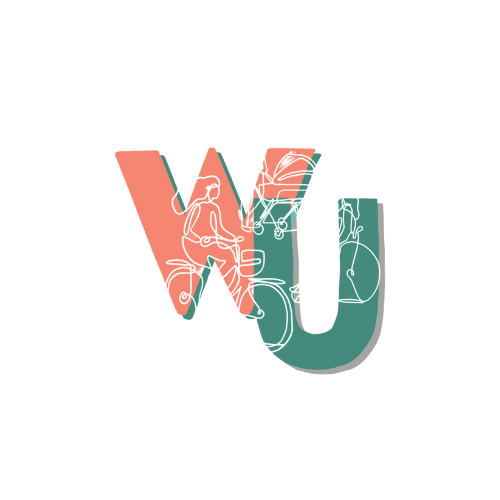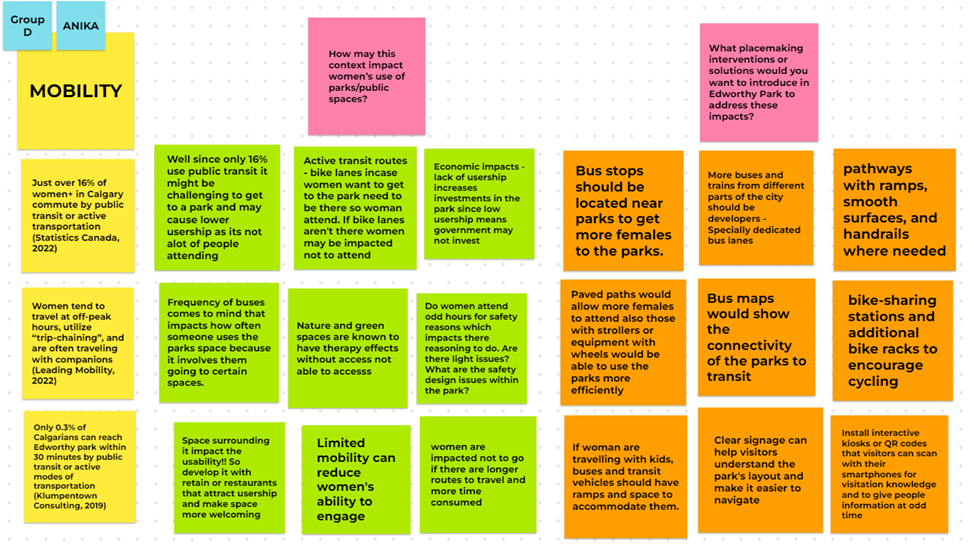Event Recap: Gender-Based Placemaking at Edworthy Park
On Thursday October 19th, Women in Urbanism Canada (WIUC) hosted the final workshop of the three-part virtual series on creating gender-inclusive public parks. The workshop included a presentation from Afrin Islam, B.Arch, MLA, Candidate at the University of Calgary and Michelle James, MPH, Public Policy Specialist at the Women’s Centre of Calgary. This workshop was moderated by WIUC’s board member, Varvara Belenko, and focused discussions around Edworthy Park, a large 169-hectare park that spans within Calgary’s Bow River valley.
We would like to extend our sincere thanks to everyone who participated in this workshop fo co-creating an engaging and insightful conversation with us. Below is a summary of our workshops, key takeaways, and a link to the video recording.
People boarding a floating raft in Bow River, Edworthy Park. Photo taken by Varvara Belenko.
Audience
This event was attended by a wide variety of groups. First, we saw participating students from three universities: University of Alberta, University of Calgary, and University of Northern British Columbia. Second, there was significant representation from municipal staff from the Cities of Edmonton, Burnaby, and Ottawa. Participants from private consulting firms and local non-profits also took part in the event.
Group photo of workshop participants
Presentation
Michelle James’s presentation reflected on her work at the Women’s Centre in Calgary and introduced the audience to how gender can act as a barrier for women who navigate urban spaces.
Michelle shared two key elements that she finds affect the urban life of gender-diverse people:
Key Message #1 Safety, domestic labour and caregiving responsibilities, and accessibility are the three biggest challenges faced by women who approach Women’s Centre Calgary.
Key Message #2: It is important to consider barriers faced by gender-diverse people through an intersectional lens, as those have an impact on how this community experiences the urban realm.
Map of Edworthy Park, City of Calgary
Afrin Islam’s presentation focused on placemaking to create vibrant, sustainable, and inclusive spaces. She introduced the audience to her Calgary projects that utilise placemaking design concepts and tactical urbanism to improve the North Bank of Bow River, former Lilydale factory in Ramsay, the Pedway of the Telus Convention Center, and Collector Road improvement in Martindale.
Key Message: It is important to consider barriers faced by gender-diverse people through an intersectional lens, as those have an impact on how this community experiences the urban realm.
Activity
The workshop activity encouraged participants to collectively discuss how gender impacts the use of parks and what potential interventions can be considered to improve gender equity in Edworthy Park. Each breakout room was provided with statistics relating to demographics, social experiences, economic status, and accessibility/mobility.
For demographic statistics, some key impacts identified include:
There are currently no common social spaces within the park, impeding on the ability for various people and cultures to mix and socialize.
Some of the park is fairly steep, creating barriers for people with disabilities to access many of its spaces.
For the social experience statistics, some key impacts include:
A majority of women are engaged in political activities and issues, and if policy makers are representative of this gender, policies that are written will benefit them.
When it comes to experiencing unwanted sexual behaviours in public spaces, parks that have unprogrammed spaces, blind spots, and lack of people, can contribute to perceptions of risk and danger.
With women often providing some form of care to children or care-dependent adults, availability of public washrooms is integral for their use.
Inspired by Feminist City, a workshop participant referenced the importance of friendships for women in cities.
For the economic status statistics, some of the key items noted were:
It may be difficult for low-income people to travel to parks without the availability of public transportation or proximity to the park.
Park amenities are important to low-income people and families as they may not be able to afford paid activities and facilities.
For people who work full-time in a winter City like Calgary, hours of enjoying a park after work are limited or non-existent due to early sunsets. Likewise, for those women who work part-time or do not work, park use is extended outside of heavy-use hours.
Lastly, for the accessibility/mobility statistics, some of the impacts identified were:
With only 16% of women and gender-diverse people using public transit in Calgary, it may be difficult to access some parks due to low ridership. In this case, it is important to invest in active transportation infrastructure.
With an estimated 0.3% of Calgarians being able to reach Edworthy Park within 30 minutes by public transportation, it is evident that this limited public transit mobility reduces people’s ability and/or desire to access it.
Image of the notetaking board from Activity #1
Solutions
Some of the key solutions to the above impacts were identified as follows:
Public Transportation
Make Edworthy park more transit-accessible. Currently, the park is inaccessible to those without vehicles, or those who do not live in the immediate area.
Incorporate bike-sharing stations and bike racks at key points throughout the park to encourage access by active transportation, especially if public transit improvements are not an option.
Accessibility and Placemaking
Incorporate handrails, ramps and/or stairs into the pathways to accommodate those with limited mobility, where possible.
Improve wayfinding around the park through maps, signage, or visitor info location.
Open washrooms that are accessible year-round to support prolonged activities in the park.
Create additional points of entry into the park to reduce the amount of travel to the entry areas – this is true especially due to Sarcee Trail restricting access to much of the park perimeter from the southeast.
Hold events that utilise food trucks and promote cultural activities.
Safety
Improve lighting measures around secluded areas of the park.
Incorporate programming during various times of the day to increase eyes on the street.
Promote active bystander education and intervention for park users.
Install security cameras and emergency call phones in key points of the park to deter crime, harassment, and violence.
Improve safety measures around the railroad crossing such as crossing barriers.
Reduce the amount of blind spots throughout the park.
Play Stucture in Edworthy Park, 2023. Photo taken by Varvaa Belenko.
Conclusion
For those who would like to view the full recording, please follow this link.
We are happy to conclude this workshop series, having had intriguing sessions, including Gender-Based Inclusion at St. John’s Park and Gender-Based Climate Adaptation at Point Pleasant Park.
Thank you to our speakers, our sponsors, and our participants for making this session possible!
This workshop series is made possible with the generous support of the TD Park People Grant.






